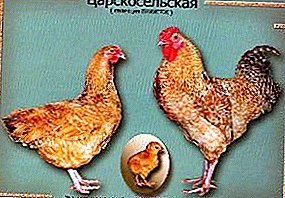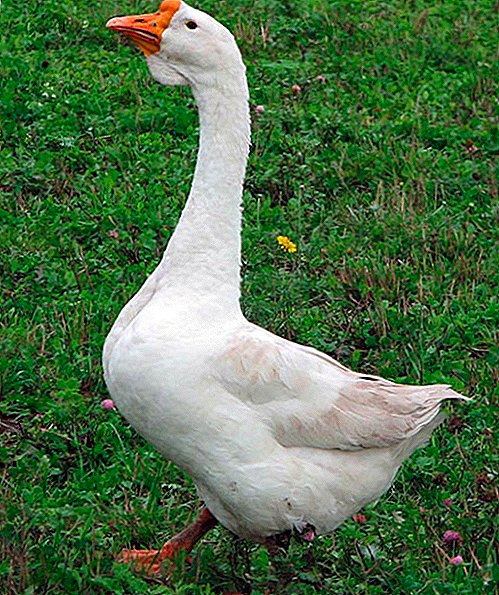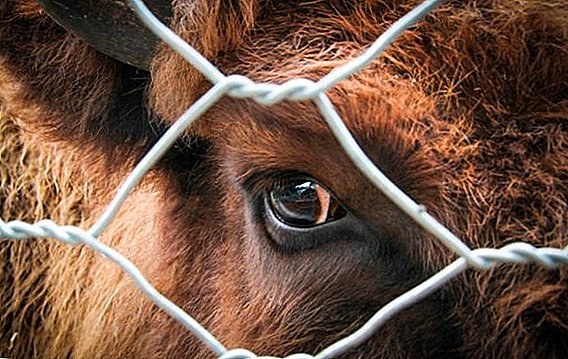 There is an opinion that cows and bulls are color blind. This is not true. They are able to distinguish colors, although not as clearly as humans.
There is an opinion that cows and bulls are color blind. This is not true. They are able to distinguish colors, although not as clearly as humans.
Their eyes are arranged in such a way as to see clearly all the objects in front of them. They do not see distant objects in details.
Why this is so and what diseases of the eyes occur in cows, we will tell in our article.
What are the eyes of cows
To understand what the eyes of a cow, you need to familiarize yourself with their structure. 
Structure
The eye of cattle consists of an eyeball with visual receptors. From them through the conductor and the optic nerve information is transmitted to the brain. The eyeball is placed in the orbit formed by the bones of the skull, and has an outer, middle and inner shell.
It also has a light refracting medium, nerve endings and blood vessels.
The outer shell is the cornea and sclera (protein shell). The latter consists of fibrous tissue and is the basis of the eyeball. Muscle tendons hold the sclera, which also ensures its operation. The cornea is transparent, without blood vessels, but with nerve endings.
It will be useful for you to familiarize yourself with the anatomy of a cow and to learn about the features of the structure of the udder of a cow.
Because of this, it is very sensitive to external influences. Through it passes the light to the retina.
The iris, ciliary body, and choroid are the middle membrane. The iris has a pigment that determines the color of the eye. In its center there is a hole (pupil), which is able to narrow and expand, thereby regulating the flow of light.
Between the retina and the protein sheath is the choroid. Through it is the power of the body from the blood vessels. The ciliary body is located between the vascular and iris. It is a muscle whose task is to hold the crystal and adjust its bulge.  The retina is the inner lining. At its back, light reflection is captured and transformed into a nerve impulse. Sticks located in the nerve layer are responsible for day vision. Cones are responsible for color.
The retina is the inner lining. At its back, light reflection is captured and transformed into a nerve impulse. Sticks located in the nerve layer are responsible for day vision. Cones are responsible for color.
The lens is located in the cavity of the eyeball. It is a biconvex lens of varying curvature. This allows you to see both near and far objects.
Vitreous body, consisting of water at 98%, placed between the lens and the retina. It is responsible for the shape of the visual organ, takes part in metabolic processes, maintains its tone and conducts light.
Eyes are located above and below the eyelids. They protect the body from mechanical damage. The inner part of them is covered with mucous membrane, in the corner there is a blinking membrane.
Cows have monocular lateral and central binocular color vision. Due to the elongation of the pupil in the horizontal direction, the animal has a panoramic vision of 330 °.
Did you know? Cows have well developed night vision. A refractive medium that enhances the light reflected from objects is responsible for this feature.
But due to the fact that the binocular vision zone is located in front of the cow, she clearly sees everything that is in front of her, but poorly distinguishes the details of distant objects. 
Colour
Basically the eyes of a black or dark brown cow. But sometimes there are other colors. It all depends on the breed of the animal.
Diseases of the eyes of cows
Diseases of the optic organ in cows are quite common. They can be caused by mechanical damage, infection, physical or chemical injury, or they occur as a result of other animal diseases.
Find out also what there are diseases of the udder, diseases of the joints, diseases of the hoofs of cattle.
Why are dull and watery
Teariness is the body's natural response to a stimulus. Together with tears, the foreign body or pathogenic microorganisms are washed away. Therefore, if you find tears in a cow, you must urgently show it to the veterinarian, as this may be a symptom of such a disease as keratitis (inflammation of the cornea).
His reasons:
- mechanical damage (bruise, shot);
- thermal;
- chemical;
- physical (burn, UV radiation, lime dust);
- infectious diseases.
 Symptoms:
Symptoms:- corneal opacity (loss of gloss);
- the color of the cornea is smoky, smoky white;
- photophobia;
- tearing;
- inflammation of blood vessels.
Treatment:
- 3% boric acid solution for washing the conjunctival sac;
- injections of antibiotics or sulfonamides;
- 0.5% solution of novocaine with an antibiotic injection by the purulent process.
The appearance of a catcher can occur due to inflammation or damage to the cornea. Scar tissue is formed, which changes the transparency of the cornea, making it cloudy. Gradually, an eyesore appears.
Important! A calf can be born with an eye catcher. This suggests that during the prenatal development he had an inflammatory process.
The reasons:
- injury;
- helminths.
 Symptoms:
Symptoms:- conjunctival redness;
- corneal clouding;
- photophobia;
- tearing;
- loss of appetite
- the animal often shakes its head.
Treatment (if helminths):
- eye washed with 3% boric acid solution with a syringe;
- ointment on the basis of penicillin and sulfonamides impose under the eyelid.
Procedures are carried out daily until complete expulsion of the parasites from the eye.
Treatment (if injury):
- 3-4 times a day to lay sugar without lumps under the lower eyelid;
- 3-4 ml of chlorophos solution are instilled into the affected eye;
- twice a day, lubricate the eye with tetracycline ointment.
All treatments should be prescribed and monitored by a veterinarian.
Why are red
 Congestion inflammation can cause redness of the optic organ.
Congestion inflammation can cause redness of the optic organ.
The reasons:
- mechanical injury (contusion, foreign body, torsion of eyelashes);
- chemical (ammonia, alkali, acid, iodine, lime dust, chemical fertilizers);
- physical (UV radiation);
- infectious;
- helminth;
- allergic.
Symptoms:
- photophobia;
- swelling, redness of the conjunctiva;
- tearing;
- inflammation of blood vessels.
Treatment:
- 3% warm solution of boric acid for washing;
- drops of 0.25-2% zinc sulfate with a 1-2% solution of novocaine;
- silver nitrate drops.

Why fester
The causes of pus in the eyes can be:
- purulent conjunctivitis;
- superficial purulent keratitis.
Symptoms of conjunctivitis:
- eyelid swelling;
- hot eyelids;
- red, edematous conjunctiva;
- photophobia;
- white-yellow pus.
Symptoms of keratitis:
- photophobia;
- sore eyes;
- purulent exudate;
- the appearance of ulcers;
- puffiness, corneal roughness, whitish-yellow color.
Treatment:
- isolation, rest;
- improving conditions of detention;
- balanced diet;
- 3% solution of boric acid or furatsilin 1: 5000 for washing;
- 0.5% zinc sulphate solution, as an astringent for conjunctivitis;
- ointment (furatsilinovaya, penicillin, iodoformnaya, xeroformnaya, hydrocortisone, yellow mercury) for eyelid with keratitis, warm compresses;
- with strong purulent processes, antibiotics and sulfonamides are prescribed.
Did you know? Bullfights on the bullfight do not react to the color of the cloth, but to the cloth itself, as an object of irritation, which they constantly wave at before their eyes.
Eye catcher (corneal growth)
The appearance of a growth on the cornea is called pterygium. Formed by the conjunctiva, the triangular fold of which is approaching the cornea.  The reasons:
The reasons:
- UV radiation;
- injury;
- chronic conjunctivitis;
- infectious eye disease.
Symptoms:
- tearing;
- itching;
- loss of visual acuity;
- corneal redness;
- appearance of spots on the cornea.
Learn more about how to treat a cataract.
Treatment. The growth is eliminated by surgery.
Mass keratoconjunctivitis
This ailment is a rather frequent phenomenon that can hit almost half of the entire population at the same time.
The reasons:
- spring A hypovitaminosis;
- helminths;
- infections.
 Symptoms:
Symptoms:- corneal turbidity;
- tearing;
- decreased corneal sensitivity;
- photophobia;
- swelling of the conjunctiva;
- cornea hardening and detachment;
- the appearance of ulcers.
Treatment:
- balanced menu;
- introduction to the diet of vitamins, fish oil;
- injection of bacteriostatic emulsions into the conjunctival sac twice daily;
- overlay synthomycin ointment with the addition of 2-3% novocaine, 1% atropine.
Important! Apply the same drugs as with conjunctivitis.
The eyes are an important organ for any animal. Problems with them arise suddenly, and treatment is not always easy. Therefore, it is better to keep the cows clean, comfortable and provide normal food than to fight disease.












